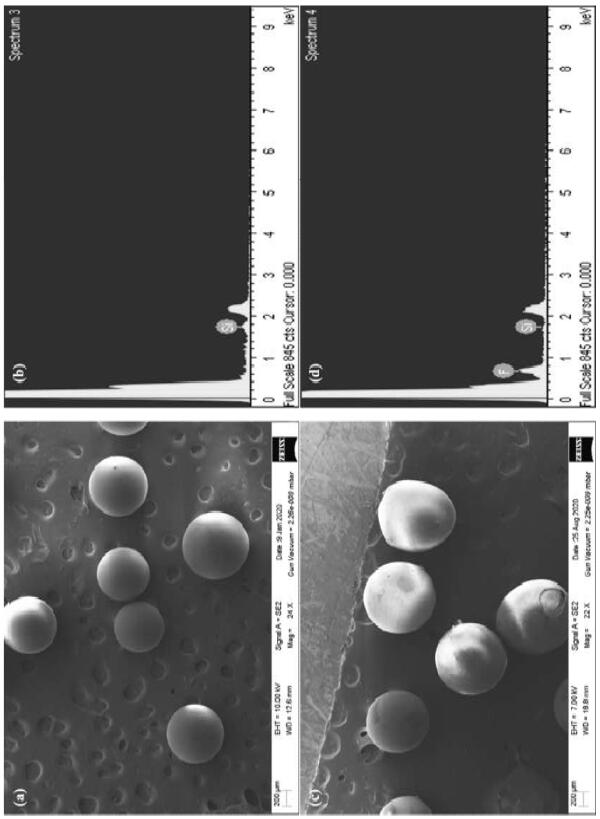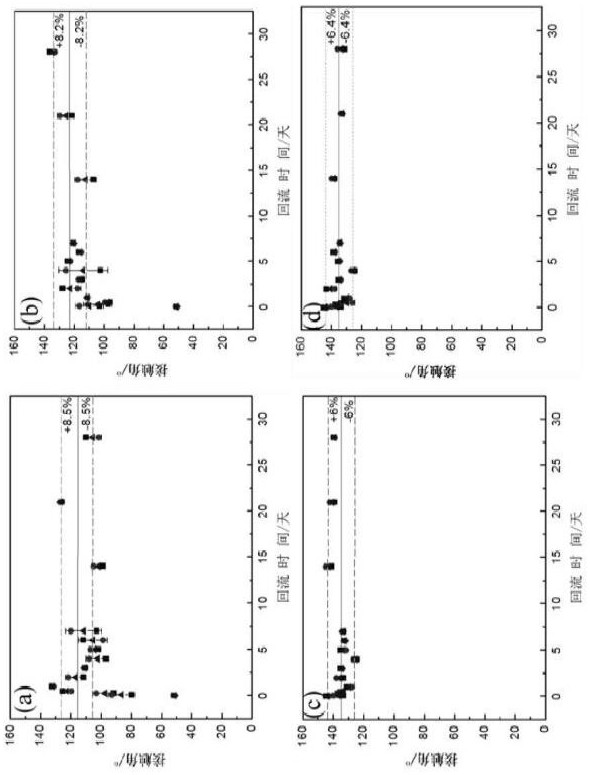Hydrophobic low-density high-strength polystyrene microsphere and preparation method thereof
A technology of polystyrene microspheres and hydrophobic type, which is applied in chemical instruments and methods, earthwork drilling and production, wellbore/well parts, etc. It can solve the problems of inapplicability and poor hydrophobicity, and achieve high productivity and long-lasting Hydrophobic properties, the effect of simple process
- Summary
- Abstract
- Description
- Claims
- Application Information
AI Technical Summary
Problems solved by technology
Method used
Image
Examples
Embodiment 1
[0057] A preparation method of durable hydrophobic low-density high-strength polystyrene microspheres, the process is as follows
[0058] In step 1, 0.4 parts of polyvinyl alcohol are dissolved in 400 parts of deionized water to obtain an aqueous phase with a concentration of 0.1%.
[0059] In step 2, 20 parts of styrene, 5 parts of divinylbenzene, 5 parts of γ-methacryloxypropyl trimethoxysilane and 0.1 part of dibenzoyl peroxide are premixed to obtain an oil phase.
[0060] Step 3: Slowly add the oil phase to the water phase. During the addition process, control the stirring speed to 40rpm and the temperature to 40°C until all the oil phase is added to the water phase.
[0061] Step 4: After all the oil phase is added to the water phase, the stirring speed is controlled at 60 rpm, and the temperature is raised to 65°C in stages, and then reacted for 1 hour.
[0062] Step 5: Suction filtration and washing to obtain the spherical core.
[0063] Step 6, add 10 parts of potass...
Embodiment 2
[0067] A preparation method of durable hydrophobic low-density high-strength polystyrene microspheres, the process is as follows
[0068] Step 1. Dissolve 4 parts of cellulose ether in 400 parts of deionized water to obtain an aqueous phase with a concentration of 1%.
[0069] In step 2, 40 parts of styrene, 6 parts of divinylbenzene, 1 part of vinyltrimethoxysilane and 1.2 parts of azobisisobutyronitrile were premixed to obtain an oil phase.
[0070] Step 3: Slowly add the oil phase into the water phase. During the addition process, control the stirring speed at 100 rpm and the temperature at 60° C. until all the oil phase is added into the water phase.
[0071] Step 4: After all the oil phase is added to the water phase, the stirring speed is controlled at 130 rpm, and the temperature is raised to 100°C in stages, and then reacted for 5 hours.
[0072] Step 5: Suction filtration and washing to obtain the spherical core.
[0073] Step 6, add 10 parts of potassium-type silic...
Embodiment 3
[0077] A preparation method of durable hydrophobic low-density high-strength polystyrene microspheres, the process is as follows
[0078] Step 1. Dissolve 3 parts of sodium dodecylbenzenesulfonate in 200 parts of deionized water to obtain an aqueous phase with a concentration of 1.5%.
[0079] Step 2, premixing 26 parts of styrene, 5 parts of divinylbenzene, 3 parts of vinyltriethoxysilane and 0.25 parts of dibenzoyl peroxide to obtain an oil phase.
[0080] Step 3: Slowly add the oil phase into the water phase. During the addition process, control the stirring speed at 100 rpm and the temperature at 45° C. until all the oil phase is added into the water phase.
[0081] Step 4: After all the oil phase is added to the water phase, the stirring speed is controlled at 150 rpm, and the temperature is raised to 70° C. in stages for 2.5 hours of reaction.
[0082] Step 5: Suction filtration and washing to obtain the spherical core.
[0083] Step 6: Add 5 parts of potassium-type si...
PUM
 Login to View More
Login to View More Abstract
Description
Claims
Application Information
 Login to View More
Login to View More - R&D
- Intellectual Property
- Life Sciences
- Materials
- Tech Scout
- Unparalleled Data Quality
- Higher Quality Content
- 60% Fewer Hallucinations
Browse by: Latest US Patents, China's latest patents, Technical Efficacy Thesaurus, Application Domain, Technology Topic, Popular Technical Reports.
© 2025 PatSnap. All rights reserved.Legal|Privacy policy|Modern Slavery Act Transparency Statement|Sitemap|About US| Contact US: help@patsnap.com



